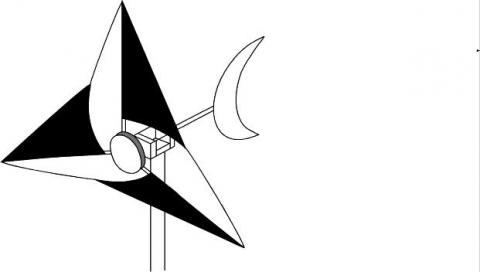Sailwing Windmill

Overview
Like the sails of a ship, a cloth sailwing blade catches the wind and gently fills to form an aerodynamic shape. Sailwings exhibit the properties of lift and drag in various combinations depending on the design and windspeed. Some sailwings have rigid supports at the blade tips so that they operate very much like the airfoil blades described later.
A sailwing consists of a triangular piece of cloth or nylon stretched over a wood or metal spar that is joined to the hub. Each sail is attached along one edge to the spar, and its free corner is tied to the preceding spar tip with a spring or elastic band. A gentle wind will fill the sail and turn the rotor. As the wind blows harder, the cloth on the trailing edge (that part of the sail that meets the wind last) stretches and spills wind in various amounts according to the tension on the spring. The sails can also be reefed, just as sails on ships are rolled up in a storm. The trailing edge is untied and then wrapped around the spar several times, thus decreasing the sail area. This keeps the sail from being ripped to pieces by gale winds. As the wind picks up, sailwings begin to ripple and flap like a banner or a kite caught in a cage.
Try this sailwing plan.
MATERIALS
2 sq yds of cloth or nylon
3/4'' plywood 1 sq ft
3) 2-ft lengths of 3/8" dowel
Elastic
1/4" iron rod
INSTRUCTIONS
1) Cut a 3" disc from 3/4" plywood. Drill three 3/8" holes around the edge of the hub at 120 degree intervals with a drill press. Push the dowels into these holes and secure with screws through the hub into the dowels.
2) Cut the sails according to the pattern. Hem the edges to prevent fraying. Attach the 12" elastic bands to the trailing edge and sew a tube 3/4" wide along the fixed edge. This tube should slide snugly over the spar. You could also simply staple the sail to the spar without a sewn tube, but this is not nearly as strong.
3) With the sails on the spars, twist a loop of wire around the tip of each spar and tie the elastic band from the next sail to this loop.
4) Build a mainframe as shown, or use this sail wing on the mainframe from the windcharger plans. Attach the hub to the shaft. Be sure to allow enough room so that the spars will not hit the tower and main frame when they bend under wind pressure. Larger sailwings have wires from the tip of the projecting shaft to the spar tips to keep the spars from bending.
